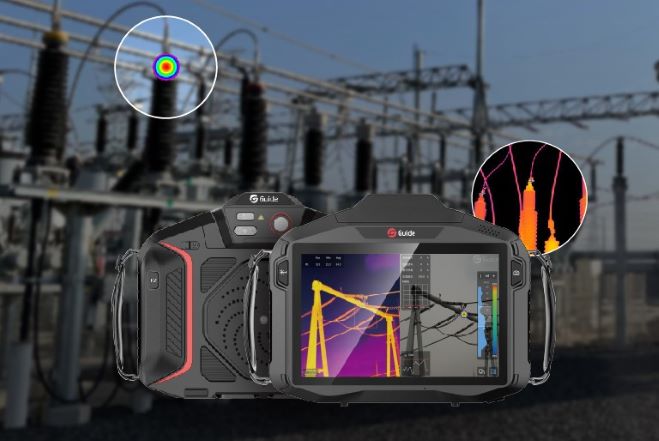An infrared thermal imager is a useful tool for detecting faults, such as electrical and mechanical faults, water leakage detection, house mold detection, and so on. This is mainly because the thermal camera can find the low and high-temperature location of the target surface, and display it in the form of infrared images, through the image and temperature display, the operator can easily find the problem areas. However, when using the thermal camera for fault detection, special attention should be paid to three points, if these three points are not handled properly, it may not achieve the desired detection effect.

What is the basic structure of a thermal imaging camera? Including 5 major parts:
1) Infrared lens: receives and converges the infrared radiation emitted by the object under test;
2) Infrared detector assembly: turns the heat radiation type into an electrical signal;
3) Electronic components: processing of the electrical signal;
4) display component: transforming the electrical signal into a visible image;
(5) software: processing of the collected temperature data, converted into temperature readings and images;
Why does a thermal imaging camera make a "click" sound? What is automatic calibration?
The "click" sound inside the instrument is caused by the automatic calibration of the thermal imaging camera, which usually occurs when the camera is moving quickly and when it is just turned on.Reason for auto-calibration: The camera automatically adjusts to changes in ambient temperature to counteract the effects of such changes on the detector's accuracy.
Using thermal imaging cameras need to prepare?
All thermal imaging cameras require sufficient set-up time for accurate temperature measurements and optimal image quality, which usually varies with the model and environmental conditions.
Although a thermal imaging camera can be substantially ready in 3-5 minutes, it is best to wait at least 10 minutes for the most accurate temperature measurements. More time may be required when moving between environments with large temperature differences.
How to choose the right resolution?
Depending on your inspection needs, a combination of image quality, accuracy, operation, and price is key. In general, a 320x240 or 160x120 camera can detect the most important problems.
How to choose the right temperature range for different applications?
Guideir's best thermographic cameras offer the best balance of excellent image quality, ruggedness, and ease of operation. Of course, if there are applications that require the detection of small targets, it is recommended that the resolution requirements for the camera be increased.
For most routine maintenance work, a range of -20°C to 250°C or -20°C to 350°C is sufficient.
A range of -20°C to 150°C is sufficient for diagnosing most building-related problems.
For R&D and other needs, you will need to choose the right product for your specific application based on the temperature detection range.
Things to keep in mind when using a thermal imaging camera
1. Understanding the maximum detectable distance of a thermal imaging camera
The maximum detectable distance of a thermal imaging camera is not a fixed figure, it depends on the size of the target and the performance of the infrared detector. For the same thermal imaging camera, if it is measuring a large area target, the detectable distance will be farther, if the target is small, then the detectable distance will be closer.
Therefore, when we measure some smaller targets, we have to find out what is the farthest detectable temperature distance when the infrared camera is measuring this large target, to ensure that the temperature detection is within the effective distance, otherwise, there will be wrong measurement results.
2. Understand the thermal sensitivity parameters of thermal imaging cameras
The thermal sensitivity of the thermal imaging camera reflects the sensitivity of the camera to temperature, the lower the value of thermal sensitivity, the stronger the thermal imaging camera's ability to distinguish temperature differences.
If we are interested in the fine temperature difference of the measured target surface, we need to know the thermal sensitivity parameters of the thermal imaging camera, for example, the thermal sensitivity of 0.04℃ can distinguish the temperature difference of 0.04℃, while the thermal sensitivity of 0.07℃ can only distinguish the temperature difference of 0.07℃.
3. Correctly adjust the focal length of the thermal imaging camera
For an adjustable focus infrared thermal imager, to get better measurement results, sometimes need to adjust the lens focal length according to the environment, this is to draw your attention.
Infrared thermal imager maintenance
1, to avoid damage to the infrared thermal imager, please first use compressed air to remove large to avoid damage to the thermal imager, particles, and dust, and then wipe with a piece of cloth. The particles and dust, and then wipe with a piece of cloth
2、Use a non-corrosive solution labeled for cleaning lenses or a mild diluted soap solution, wet it with a clean computer monitor cleaning cloth, and gently wipe the display.
3、Use a clean computer monitor cleaning cloth to gently wipe the display. To clean the thermal imaging camera body: To clean the thermal imaging camera body: use a clean and slightly damp cloth to gently wipe the thermal imaging camera body. If necessary, the cloth can be moistened with a solution made of water with a small amount of mild soap.
4、When finished using, please cover the thermal imaging camera with the lens cover as soon as possible and put, please cover the thermal imaging camera with the lens cover as soon as possible and put it into the carrying case for storage. Put it into the carrying case for storage.
Conclusion
The thermal imaging camera in use will produce certain wear and dirt, these problems will lead to the performance of the thermal imaging camera degradation. So routine maintenance is necessary for the thermal imaging camera, can reduce the dirt and wear generated, and can effectively increase the use of the thermal imaging camera life.













.svg)

(1).jpg)
.jpg)


